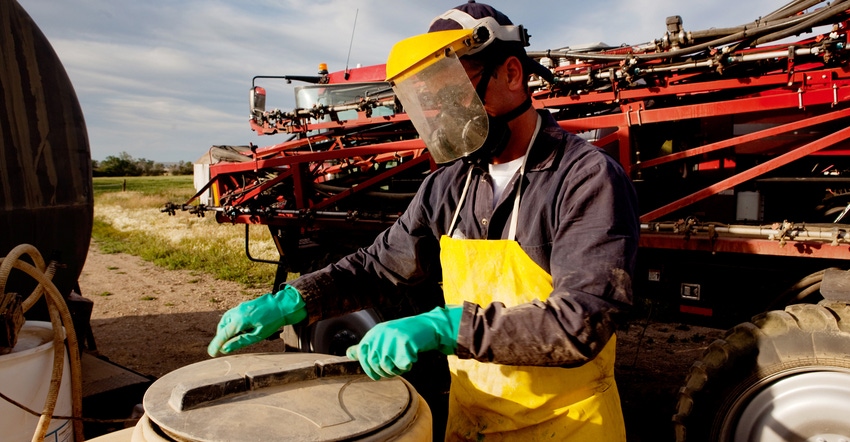
The hurry to get an agriculture chemical in the ground before the next rain finds many farmers rushing. While you read and follow label instructions for application parameters, you may be glossing over one key part of that label — personal protective gear.
According to the Upper Midwest Agricultural Safety and Health Center, pesticides can be serious irritants to skin, eyes and lungs, and can affect your internal organs and your health in the short and long term. So, farmers and farm employees need protection.
In a recent Ag Connection Newsletter, University of Missouri Extension agronomy specialist Dhruba Dhakal outlined five pieces of personal protective equipment farmers should consider using this spraying season:
1. Gloves. Pesticide labels generally specify the type of gloves needed. Dhakal recommends farmers use chemical-resistant unlined gloves during pesticide handling and application. Cotton, leather and canvas gloves do not provide protection when handling and applying pesticides.
2. Body protection. To protect the front of your body, wear a chemical-resistant apron when mixing, loading and cleaning equipment. For some products, an apron is required, along with other protective clothing to protect against spills. Make sure aprons are made from chemical-resistant PPE materials. Also, Dhakal notes they are more protective than cotton and polyester aprons.
“Disposable coveralls have become increasingly popular because of their low cost, availability and ease of use,” he adds. “They should be discarded at the end of each workday.”
3. Footwear. Whiles some pesticides can be used with simple shoes and socks, others require the applicator to wear "chemical-resistant footwear, plus socks." Chemical-resistant boots are the most protective footwear, Dhakal says. Natural rubber, which may be coated with polyurethane, polyvinyl chloride or blends of these materials, make up these types of shoes. Shoe covers can also be used over footwear that is not chemically resistant, such as fabric and leather shoes.
4. Eye and face protection. “Common sense should determine which type of protective eyewear is appropriate,” Dhakal says. Excluding the full-face respirator, there are three basic types of protective eyewear — chemical splash goggles, face shields and shielded safety glasses.
Safety glasses provide minimal protection, he explains, and should only be used when handling the least toxic pesticides. “Chemical splash goggles always provide better eye protection than safety glasses,” he adds. Face shields can be used with safety glasses or goggles for protection against pesticide splashes.
5. Respiratory protection. Use only respirators approved by the National Institute of Occupational Safety and Health and the Mine Safety and Health Administration. Approved respirators will carry a "TC" number prefix, which signifies they have been tested and certified for a specific level of protection, Dhakal explains.
There are two types of respirators: air-purifying and air-supplying. “Air-purifying respirators should be used where there is sufficient oxygen,” he says. “They remove airborne contaminants as air enters the respirator through chemical cartridges or mechanical filters. The chemical cartridges are filled with activated carbon, which has a very high absorption capacity for gases and vapors. Mechanical filters provide protection by trapping particulate matter in the fibrous filter material.”
An air-supplying respirator supplies an independent source of breathable air and is used in conditions where oxygen is deficient or the applicator is exposed to high concentrations of very toxic pesticides in enclosed areas.
To learn more about personal protective equipment, refer to University of Missouri guide 1917 at extension.missouri.edu.
Read the label
Every pesticide product label contains specific information about necessary clothing and equipment to be worn while mixing, loading and applying that product.
This information may be found in the "Precautionary Statements" section of the label. The label is the law. Farmers must read it and wear the appropriate protective equipment.
For more detailed information about chemical and physical hazards associated with a specific pesticide, read the Safety Data Sheet for that product. The SDS is available from the pesticide dealer.
The University of Missouri Extension contributed to this article
About the Author(s)
You May Also Like






